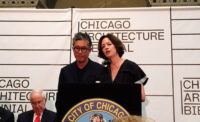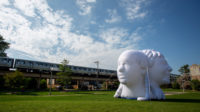With a Full Opening Still Ahead, the Chicago Architecture Biennial’s Fifth Edition Commences at Select Sites

Themed “This is a Rehearsal” and organized by art and design collective Floating Museum, the fifth Chicago Architecture Biennial (CAB 5) sees the biennial as a city-wide collaborative and spontaneous cultural happening; a reflection of the simultaneously banal and grand ambitions that create urbanism every day. “For us, the biennial is a platform for thinking about the way the city produces itself. Today, we are producing the city,” says Andrew Schachman of Floating Museum.
But as citizen-designer-actors took the stage on September 21 to clear their throats and practice their lines, the first views were of a few halting performances wrapped in progressive rhetoric that’s otherwise floating in a void of programming. Whether by improvisation or plan, the phased opening of the 2023 edition of CAB began with a small handful of installations and performances that were most effective when they harkened back to the curatorial aims of the 2021 biennial and its focus on community engagement. Attention elsewhere makes it hard to assess what the full opening November 1 will entail. Is this a rehearsal for a rehearsal?

Floating Museum members pictured from left to right at the CAB 5 kickoff event: Jeremiah Hulsebos-Spofford, avery r. young, Faheem Majeed, and Andrew Schachman. Photo by Ingrid Bonne, courtesy CAB
Eventually, CAB 5 will encompass exhibits at the Graham Foundation, the Chicago Cultural Center, Helmut Jahn’s Thompson Center, and 10 other sites, and more programing and exhibitions are slowly trickling out. As with much of Floating Museum’s work (composed of Schachman, Jeremiah Hulsebos-Spofford, Faheem Majeed, and avery r. young), Chicago’s city agencies, like the Department of Housing and the Department of Transportation, will be active participants. And like last time, the show will come with a long tail of programming. “We’re skeptical of this format of exhibitions opening and closing,” says Hulsebos-Spofford. “We’re real seed-planters.”
At the Grow Greater Englewood urban farm on the city’s South Side, planting seeds isn’t a metaphor. Located at the foot of a 2-mile-long elevated rail corridor that’s to be converted into a linear park anchoring an “agro-eco district,” Bweza Itaagi, Englewood Nature Trail and Plaza steward, says that the farm is meant to “heal the land and create spaces for the community.” For CAB 5, the farm will host a 40-foot-tall wood-framed water tower, just now under construction, designed and built by French-Afghan artist and architect Feda Wardak.

Feda Wardak presents his under-construction installation, The Water Tower - Making the invisible visible, developed with Grow Greater Englewood. Photo by Ingrid Bonne, courtesy CAB
Shamiana by SpaceShift, a collective of artists and designers, is perhaps the most successful of the early entries because it clearly telegraphs the urban vitality and cultural diasporas of the place that inspired it. Located in a South Asian neighborhood along Devon Avenue on the city’s North Side, the installation adds textural, material, aural, and olfactory experiences to a sensorily rich ethnic enclave.

Illustration of Shamiana by SpaceShift. Image courtesy SpaceShift
Though likewise at an embryonic state, Shamiana features a wood seating planter shaped like abstracted jasmine foliage, interspersed with plants (chilies, mustard, fragrant basil) used in the cuisines of the people who live in the neighborhood. There will be 60 of these planters when the installation is complete, as well as a hand-sewn fabric canopy structure inspired by the Banyan tree, with a platform and stage for large events. An installation by artist Osman Khan attaches an air quality monitor that responds to pollutant fluctuations with South Asian birdsong and musical rhythms tapped out on woodblocks. These sites, sounds, and smells are mixed with boutiques selling iridescent saris from their front windows and halal restaurants hawking savory dishes; it’s an experiential buffet where architecture and landscape architecture can sit back and curate the best of urban life.
“We want people to understand that streets can be places to gather and exchange ideas, and that we can foster cities that have more plant life that represents the places that we come from,” says SpaceShift member and IIT landscape architecture professor Nilay Mistry.



BioBlock, developed by SOM and Prometheus Materials, on view at the Mews at 167 N Green Street in Fulton Market. Photos © Dave Burk/SOM
Conversely, several of the initial installations focused on material technologies, blurring the focus away from how people work together to create community. Developed by SOM and Prometheus Materials, Bio-Block Spiral is an assembly of concrete masonry-like blocks made from dried algae, bonding agents, and aggregate, in a carbon-neutral composite that’s chemically similar to calcium carbonate, the material coral is made of. SOM’s Ryan Culligan says that it has better tensile and compressive strength than concrete. Though it can be molded and pressed, its lighter density and fibrous grain is reminiscent of wood.

Instllation view of HygroShell at the James R. Thompson Center. Photo by Ingrid Bonne, courtesy CAB
The other CAB material showcase takes a more hands-off approach. The first installation in the Thompson Center’s spectacular atrium, HygroShell, is a series of arcing sail-like wood sheets topped with shingles that was designed by a team, including students, from the University of Stuttgart. “Instead of using very energy-intensive construction processes, we want to use the innate properties of the wood itself to generate form,” says Laura Kiesewetter, a research associate at the university. The pavilion is formed by warping wood through altering its level of moisture. In this process, the students and researchers examine the ambient moisture of the wood and angle of its grain, and select relevant pieces of lumber, all cut to desired dimensions determined by an algorithm. These sheets can be flat-packed and shipped, and the drying process warps the sheets into the wafer-thin desired form in a day. They are essentially “embedding the geometry in the factory,” says student Oliver Moldow.
.webp)

Democratic Sculpture 7 by Gelitin, presented as part of the CAB 5 kickoff event at the Chicago Cultural Center. The mammoth slice is now on view at the Neubauer Collegium. Photo by Ingrid Bonne, courtesy CAB
Democratic Sculpture 7 by Viennese art collective Gelitin is a less rigorous material experience. At the University of Chicago’s Neubauer Collegium, this wedge of discarded clothes are shaped into a pizza slice and elevated off the ground by benches beneath holes to poke your head through and survey the slice’s toppings, of which you are one. There wasn’t much contextualization as to what this has to do with architecture, the biennial, or Chicago, except for the acknowledgement that food deserts plague many Chicago neighborhoods. It’s a folly, and a risky choice when it represents a significant portion of the total content on view. If this is a rehearsal, then Democratic Sculpture 7 is time for a nervous joke before the real show begins, which could look cleverly transgressive if it goes off well, and blithely clumsy if it doesn’t.



